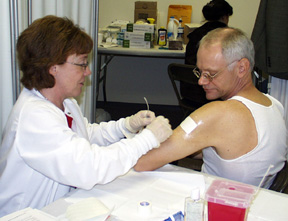 |
 |
Chris Bert, RN, of the Douglas County Health Department administers the smallpox vaccine to Steve Hinrichs, M.D., then applies a bandage to the site. |
With 15-needle pricks in his right arm, Steve Hinrichs, M.D., joined the state’s smallpox preparedness team.
The director of the Nebraska Public Health Laboratory and the University of Nebraska’s Center for Biosecurity, was first inoculated for smallpox almost 50 years ago. He never dreamt he’d need to be inoculated again.
But Friday, citing “a little apprehension because of the possible side effects,” Dr. Hinrichs received his non-emergency smallpox vaccination at a Douglas County Health Department clinic near 128th and Dodge streets.
Dr. Hinrichs, professor in UNMC’s department pathology and microbiology, will serve on a 2,500-person bioterrorism response team that would vaccinate all 1.7 million Nebraskans within four days of a confirmed smallpox outbreak. That includes individuals who were vaccinated years ago because health officials assume the old vaccine has worn off by now.
Similar vaccination programs are taking place across the country as part of the federal Homeland Security Program.
|
|
The process
Individuals who have never had the smallpox inoculation receive only three shallow pricks with a two-pronged needle, called a bifurcated needle, said Ann Tripe of the Douglas County Health Department. Those who were previously vaccinated need to be pricked with the needle 15 times to overcome any built-up immunity to the vaccine and to ensure protection.
Possible side effects to the vaccination include fever, excessive swelling, and transfer of bacterial infection from the primary site to the skin or eyes.
On Friday, after reading and completing the necessary paperwork, Dr. Hinrichs watched a 10-minute informational video and went through a screening process before receiving the vaccination, which does not contain the live virus. Dr. Hinrichs will return to the clinic this week to determine if the vaccination was effective. If not, he will receive another vaccination.
Physicians at UNMC are interested in therapeutic intervention for reactions due to the vaccinia virus, Dr. Hinrichs said. “There are antiviral drugs that could be used to treat viral infections related to smallpox or vaccinia virus complications,” he said.
Mini-medical school on smallpox
For more information on smallpox, visit UNMC’s mini-medical school Web site on smallpox (www.unmc.edu/smallpox). The three-part series kicked off Feb. 13 with 181 people attending in Omaha and 325 people participating in 14 sites across the state. The three-part series, which is free and open to the public, continues Feb. 20 and Feb. 27 from 6:30 to 8:30 p.m. in the College of Nursing. Individuals may register online or by calling 559-4315.